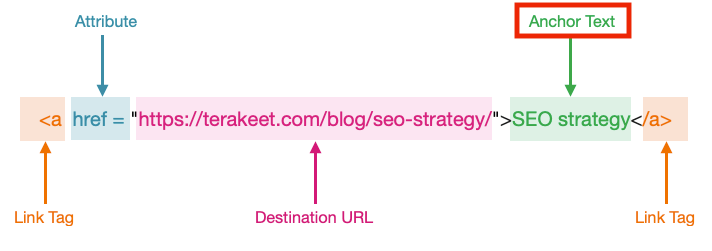
What Is Anchor Text? (Do’s and Don’ts to Optimize Link Text)
May 5, 2022|Read time: 11 min.
Key Points
- Anchor text refers to the clickable text within a hyperlink that takes users to a new destination URL on the internet.
- Treat anchor text differently for internal links vs backlinks.
- Anchor text intent is just as important as keywords.
Anchor text has been around since the beginning of the internet. Google has evolved significantly over the last 20+ years, but SEO advice hasn’t kept up with the changes. I read several articles while drafting this post, and none of them really nailed it. In fact, some conflated links with anchors, and a few came dangerously close to spreading SEO myths.
That’s a big problem because anchor text is a very important Google ranking factor. Bad advice won’t just waste your time, it also impacts your organic search traffic and user experience.
What is anchor text?
Marketing term
Anchor Text
Anchor text refers to the clickable text within a hyperlink that takes users to a new URL on the internet. By default, the text is blue and underlined so it stands out from plain text. However, webmasters can customize the style of the text however they want.
SEO beginners often conflate anchors with links because it’s the visible part of the HTML element. However, it’s just one part of the broader element. As you can see in the anchor text html illustration below, the element contains two tags, an href attribute, a URL value, and anchor value.

You’re probably thinking this sounds straightforward, so what’s all the fuss about? The truth is: if anchor text wasn’t a ranking factor, then this would be the end of my article. But there’s a lot more to cover, including some fairly controversial opinions.
Why anchor text is important
Link text is a critical part of your SEO strategy because it affects your off-page and on-page SEO efforts, as well as user experience. I’ll break down each one below.
Backlinks
Backlinks are one of the top three ranking factors in Google’s algorithm. Links from high-quality domains help establish credibility and authority much more than links from low-quality websites. As a result, they’ll help you rank higher in the search engine results pages (SERPs).
However, links don’t just pass along authority signals. They also convey vital information such as intent, context, and relevance from one webpage to another through anchor text. This helps search engines understand what a page is about and how it relates to other pages within the link graph.
For instance, imagine a webpage about content marketing links to your article about the different types of content marketing using that text. That highlighted text reinforces the topical connection between those two pages for search engines.
In most cases, you don’t control the anchor text for backlinks, so they tend to use more natural language. Read the best practices at the end of this article for specific tips to use anchor text.
Internal links
Internal links don’t add PageRank to your website the way backlinks do. However, they do help move existing authority around your site. As you may have guessed, internal links also leverage the power of anchor text to help search engines understand the connection between pages on your own website.
The best part about internal linking is you control the anchor text. That means you can vary the words each time you link back to specific pages to maximize relevance and context.
For instance, I frequently link to Terakeet’s SEO strategy blog post using the following keyword phrases:
- Build an SEO strategy
- Create your SEO strategy
- How to develop an SEO strategy
- Effective SEO strategy
- SEO strategy
- SEO strategies contain
- SEO plan
- Etc.
Check out the webinar below if you have time. I joined my colleague Angela Skane along with the folks from Clearscope to talk about these points. I skipped ahead in the video below to the section define anchor text and talk about specific details.
User experience
User experience has become ingrained in SEO over the last several years, and the trend is likely to continue. Unfortunately, the industry still prioritizes keyword matching and authority when building links at the expense of user experience.
I’m sure you’ve all received a pitch like this: “Can you link to our CMS service page where you mention ‘great customer service’ in your article?”
Obviously, that’s not the right fit. Based on the intent of the anchor text, users would expect that link to point to a page describing great customer service.
Fortune 500 Enterprise SEO Playbook
Discover how enterprise brands can create content that builds authentic audience connections.
Different types of anchor text
SEO professionals waste a lot of time sculpting link text profiles to match some mythical percentage they read about online. To be clear, there is no ideal, universal percentage of exact match anchor vs branded vs generic, and so on.
Each industry is different. Each keyword is different. In some cases, it might be very hard to use exact match keywords naturally in your sentences. In other instances, it may be difficult to avoid. It’s best to look at your SERP competitors to understand what others are doing.
Before I dive into best practices, I’ll walk through the various anchor types you should know about. I’ll work down the list from the most keyword-rich to the least.
Exact match anchor text
Exact match links precisely matches the keyword you optimized your page to rank for. Here’s an example:
Terakeet can help you develop a holistic SEO strategy.
Keyword-rich anchors like this are incredibly powerful, but they’re also risky in certain situations. This is one of the more controversial topics in the SEO industry due to misinterpretation.
Firstly, Google states we should avoid keyword stuffing links. However, they also state we should use short, descriptive text. This may seem contradictory, but I believe what Google means is we should not unnaturally pack keywords into link text.
Secondly, Google views over-optimized anchor text as manipulative because it’s often unnatural and it indicates you may have built the links. In fact, that’s what Google’s penguin update in 2012 specifically looked for.
Think about that for a moment.
Google doesn’t view exact keyword match links as manipulative in all cases. It’s only when those links come from other domains you don’t control. However, you own and control the content on your own website. So, you can use any anchor you want without risking an over-optimization penalty.
That said, I still recommend using a variety of anchors on internal links because it gives Google more context about your content.
Broad match anchor text (phrase match)
Broad match anchor text (sometimes called phrase match) includes your target keywords as well as other words. Here’s an example:
Terakeet can help you develop a holistic SEO strategy.
Broad match is an excellent way for you to convey both the topic of your content and the intent of the content you linked to. It includes keywords, but it’s not overly optimized. Broad match anchor text also offers an excellent opportunity to use long-tail keywords when linking back to your content.
Partial match anchor
Partial match anchor text includes part of the target keyword or a variation of it, but not the exact keyword. Here’s an example:
Terakeet can help you develop a holistic SEO strategy.
Related anchor text
Related anchor uses synonyms or closely related terms, but it doesn’t contain any of your keywords. Here’s an example:
Terakeet can help you develop a holistic search engine optimization plan.
Use this type of link to help search engines understand similar words and phrases that mean the same thing as your target keyword.
Branded anchor
This type of anchor text contains a specific brand name, website, or product name. Here’s an example:
Terakeet can help you develop a holistic SEO strategy.
Use this link text when you broadly mention a company or individual. These types of links usually point to a website’s homepage, and they’re an important part of a natural backlink profile.
Naked URL link
Naked anchor text is just the URL of the destination page. Here’s an example:
Terakeet can help you develop a holistic SEO strategy: https://terakeet.com/blog/seo-strategy/
Naked URLs aren’t very effective at helping users or search engines understand the content of the linked page. They also tend to disrupt the user experience because they feel spammy and amateurish.
The only instance in which it may be acceptable to use naked anchor text is when citing sources at the bottom of an article. But it’s still ideal to use the title of the page instead.
Generic anchor text
Generic anchors include non-descriptive words like “click here,” “read more,” or “learn more.” Here’s an example:
Terakeet can help you develop a holistic SEO strategy. Read the article.
This type of link doesn’t give users or search engines any information about the linked page. Even worse, if you use this throughout your website, then all your pages could be linked to with the same anchor.
These links are more useful when it’s used as a call-to-action with accompanying descriptive text. For example, if you want visitors to download a resource, it’s appropriate to use “Click here to download your digital marketing guide.”
Image alt text
Images of all types can also use links, but you can’t add image anchor text. Instead, the alt text of the image serves as the link text. If you don’t use alt text, then Google will interpret that as a naked.
Make Connections that Matter
Uncover what your customers are looking for in real time and meet their needs with valuable content.
Best practices for using anchor text
Regardless of what you may read, there’s no industry standard for link anchor percentages. So rather than toss out a bunch of inaccurate percentages, I’ll offer some advice for how to use it properly across a variety of links.
I discuss the following points further in the ICARE framework section of my internal linking strategy article.
Be relevant
Choose anchor text that’s relevant to the page you link to. Irrelevant link text disrupts user experience and raises flags for Google.
Let’s look at an extreme example in the following sentence.
Diamond drill bits are made from diamond powder.
I can’t bring myself to do it, but imagine the word “diamond” above links to a diamond engagement ring page. Clearly that would be irrelevant because engagement rings are not discussed at all in the sentence.
Match link intent
Anchor intent should match the intent of the destination page. In other words, if the intent of your anchor is informational, then you shouldn’t link to a service or product page. Here’s an example:
Stronger customer relationships lead to better customer loyalty.
Imagine I linked the bold text above to a customer relationship management (CRM) solution page. Technically that link has some relevance because I’m discussing customer relationships. However, the intent of that anchor text suggests that I’m linking to an informational article to support my claim rather than a commercial page.
Consider context
Make sure your anchor text is contextually relevant to the sentence as well as the destination page. Although context is similar to relevancy and intent, it’s unique enough to mention separately.
Consider this example:
Red Bull’s content marketing is exceptional.
Imagine I linked the bold words above to our content marketing guide. It would be relevant, and the intent is right. But based on the context, that link should point to an article specifically about Red Bull’s content marketing.
You might think that’s getting a bit too picky. But I’m a purist. There’s probably a better place to add the link that makes more sense.
Furthermore, Google’s patent titled “Ranking based on reference contexts” indicates Google may assess the surrounding text to understand the destination page.
With this in mind, when inserting anchor text, make sure the surrounding text provides additional contextual clues for the content of the linked page.
Be natural
Another anchor text SEO best practice is to make sure the link text reads naturally. The keyword should flow within the sentence and make sense to the reader. If it feels out of place, don’t do it. Here’s an example that I see far too often:
A Houston SEO company is a great way to get more traffic.
Imagine the link points to an SEO company website in Houston. The intent, relevance, and context are all fine. But it’s awkward and very unnatural.
Google has consistently stated content should be created for users first and search engines second.
Keep anchor text short
Keep link text short and descriptive. It’s better for users and it more concisely explains what the destination page is about. One exception might be if you link to an article using the title as the link text.
Vary your anchors
Use a variety of different keyword variations in your anchor text, including exact match, broad match, long tail, and related. As a result, you’ll maximize Google’s understanding of your content and reduce the risk of a manual action from over-optimized backlinks.
Additionally, use synonyms and extra words that convey context and intent.
This creates a more natural anchor text distribution and helps to improve search engine rankings for more keywords
On-Page SEO Checklist
Get Terakeet’s checklist for on-page optimization and copywriting.
Use descriptive keywords in image alt tags
Alt tags with images serve several purposes:
- Help Google crawlers understand what the image is, as well as the content of the page it’s linked to.
- Help visually impaired individuals gain a better grasp of the image.
- Function as anchor text.
If you’re using images with links, make sure to include descriptive keywords in the image alt tags. Don’t cram the text with keywords; it should be natural within the sentence.
Avoid messy naked links
If you’re going to use naked links, keep them short and descriptive. For example, if you’re giving away a free downloadable e-book, the naked link should be something like: www.website.com/free-ebook.
Messy naked links like www.website.com/1x9jk3vvqr don’t give site visitors or search engines any idea about the content of the destination page.
Consider accessibility
Finally, think about your users when you style your anchor text. All links should clearly stand out from the rest of your copy. Don’t use colors that are difficult to read or too close to the color of the rest of your text, or users won’t click on your links.
The Brand Intelligence Report
Exclusive AI insights, search trends, and brand strategies, delivered to your inbox.




